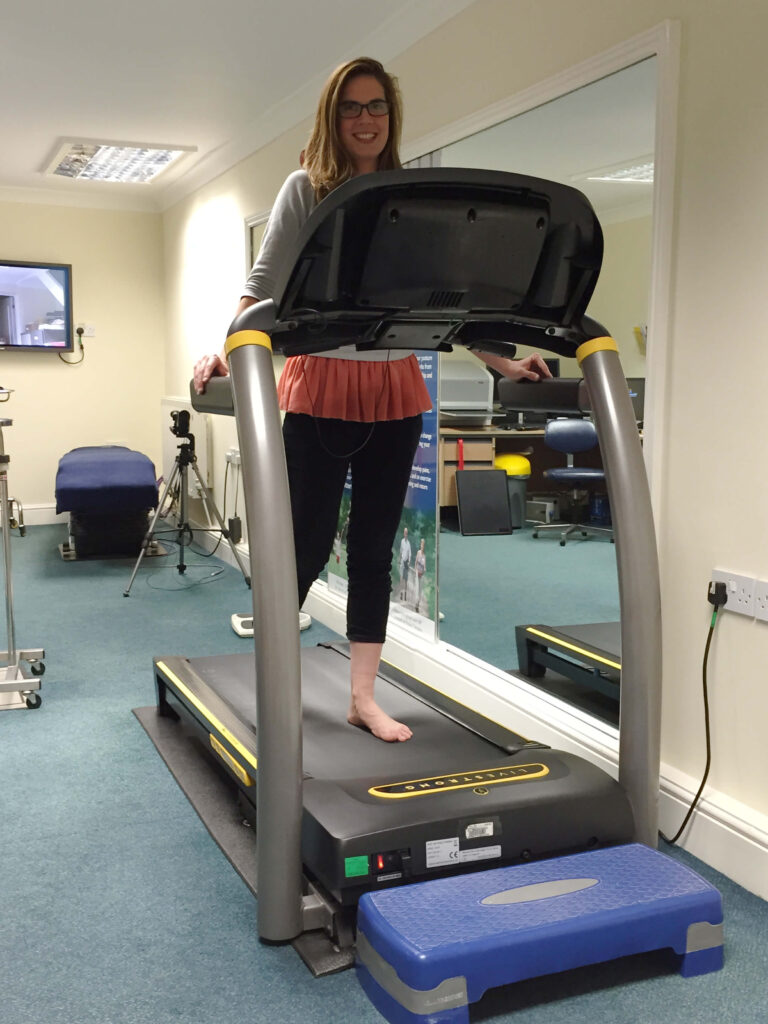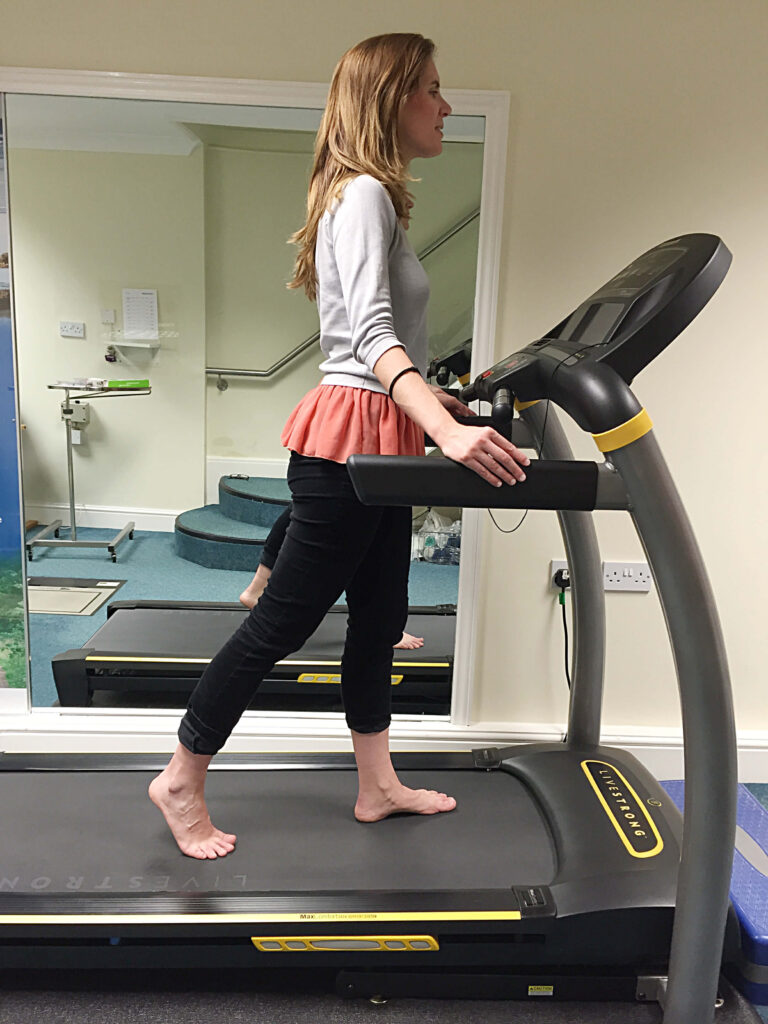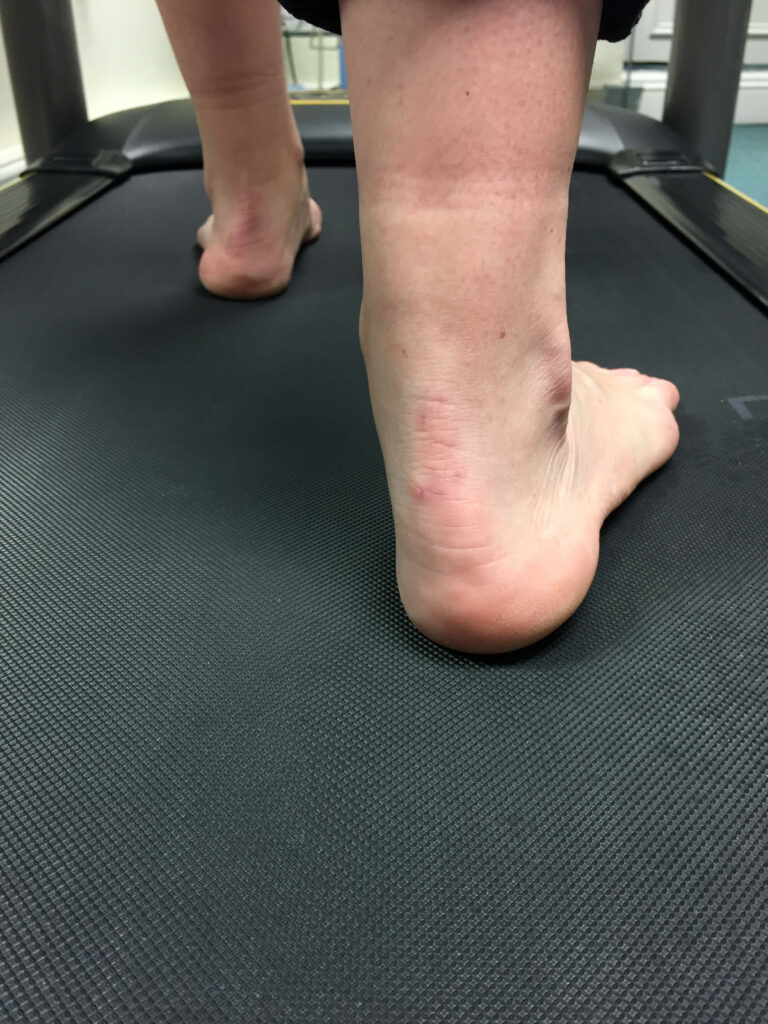Slow Motion Gait Analysis
What is Gait Analysis?
Video Gait analysis is the systematic study of walking or running. Using slow motion film it is possible to view joints in each phase of movement to assess if function and alignment is normal. Gait analysis is used to assess, plan, and treat individuals with conditions affecting their ability to walk. It is also commonly used in sport to help athletes run more efficiently and to identify posture-related or movement-related problems in people with injuries.
Feet are amazing machines, managing without complaint most of the time to transmit the weight of the body as we propel ourselves around at varying speeds, all the while keeping balance and a secure connection with the surface. While foot posture can vary greatly without particular painful problems, many alterations in foot posture can result in painful symptoms and significant levels of disability. The levels of force transmitted through the feet demand strong and flexible joints, muscle strength and neuromuscular coordination for balance and control.

What is gait?
The term ‘gait’ is used to describe how your legs and feet act when you walk and run. It includes may factors, including how your weight moves from side to side and front to back, the way your legs move at the ankle, knee and hip, the way your foot flexes and twists and how your feet strike the ground and lift you off it. As you walk and run with a normal gait, all these factors act in a regular cycle, repeating smoothly and evenly with each step you take.
Your gait is determined by a number of factors. These include the shape, length and strength of your bones and joints, the length and strength of your muscles, tendons and ligaments – and the way all these work together during movement. A normal gait will be economical, using the minimum amount of energy to walk or run.
Why should I have my gait assessed?
Gait analysis can be useful in preventing, diagnosing and treating pain and injury connected with abnormal gait.
- Gait assessment may be useful to diagnose the reason for pain you encounter while walking or running.
- Gait assessment may help diagnose underlying medical conditions
- Gait analysis can be used to plan needed foot surgery to achieve best results.
- Gait analysis my help prevent pain and injury from running and other sports
How is my gait analysed at my initial consultation?
One of our qualified podiatrists will look after you during this consultation.
Gait analysis usually involves being filmed walking on a treadmill. If you have a sports injury we may also ask you to run on the treadmill. We will ask you to undress and just keep your underwear on, so do wear underwear that you feel comfortable being filmed in. We ask you to remove your outer clothes so we can assess your feet, knees, hips, pelvic tilt, shoulders, arms and back alignment.


While on the treadmill you will be filmed from the front, back and sides. The film will be replayed in slow motion and freeze frame to assess each joint while you are at your appointment.
Will I be offered further gait analysis?
You will be advised of your initial diagnosis and we will either recommend a particular course of treatment, or suggest further investigation to enable us to make a fuller diagnosis. This may be a biomechanical assessment, a fuller gait analysis using our computer pressure plate technology which lets us more specifically assess individual joints and muscles. We might also advise an X-ray scan, which we can do in-house, or an MRI scan for which we will refer you to a specialist centre.
If, at your first consultation, our podiatrist recommends handmade orthotics, and you agree to this, an appointment will be made for a pressure plate analysis. For further details of what is involved, read about Costs for Orthoses below.
Please also see Your first appointment.
About abnormal gait
What is abnormal gait?
With an abnormal gait, some of the factors mentioned above will be such that your gait is uneven, asymmetrical, inefficient or painful. For example, if one leg is longer than the other or one foot flatter than the other, your gait becomes asymmetrical, and behaves with different timing from one side to the other.
This can lead to overuse muscle syndromes, muscular weakness and joint pains.
What causes abnormal gait?
Apart from the conditions (unequal leg length, unequal arches) mentioned above, abnormal gait may be caused by a range of biomechanical abnormalities arising from injury, accident, congenital conditions, and by other pathologies.
What is a Pathological gait?
Your movement may reflect an underlying problem caused by a stroke, arthritis or a neurological condition such as cerebral palsy or be different due to the results of a stroke.
The study of your movement and gait allows diagnosis and intervention strategies to be made, as well as planning for rehabilitation.
_____________________________________________________________________________________________
Biomechanical Abnormalities
What are Biomechanical Abnormalities?
Examples of biomechanical abnormalities include
- Overprontion of the feet
- Oversupination of the feet
- Internal knee positions
- An increased Q angle from the hip
- A scolisois of the back
- A leg length difference
- A difference in arch height between each foot
- Hip Hitching (lifting the hip on one side)
- Pelvic tilt
- One hip leading in front of the other at all times
- Ankle equinus
- limited ankle movement.
What harm can poor gait biomechanics do?
Many injuries in normal people are often caused, at least in part, by poor gait biomechanics.
These include:
- Dengerative arthritic joint pains
- Achilles tedonitis
- Trapped nerves
- Hallux valgus
- You may just feel that your posture is deteriorating but have no specific pains in your legs and feet.
- Plantar fasciitis
- Heel pain
Runners and Athletes
Runners and athletes whose sports require a high level of running and jumping should make sure they have had a gait analysis and buy the correct footwear to avoid future overuse injuries.
Common overuse injuries associated with poor gait biomechanics:
- Shin Splints
- Plantar fasciitis
- Iliotibial Band syndrome
- Knee pains from Ilio-tibial band syndrome or patella tendonitis
- Inguinal ligament pain – at the inside & front of the hip
- Low back pain
Read more about how gait analysis can help your running.
Children
Children’s Gait abnormalities can cause:
- Heel pains – Sever’s apophysisits
- Knee pains – Osgood Slatter’s osteochondritis
- Flat foot pains – Sever’s disease
Here is a link to our page on children’s problems.
_______________________________________________________________________________
What can be done about abnormal gait?
- Abnormal gait leading to painful walking or running can often be treated with orthoses – foot support insoles which can prevent you from overusing certain structures and so help you recover from your problem.
- For more acute conditions, such as recovery from a fracture or serious ankle sprains or muscle tears, a cast may be indicated.
- Physiotherapy and Osteopathy may be recommended to help with balancing muscle use or skeletal alignment, and may be combined with exercise recommendations.
- For conditions where surgery is indicated, gait analysis can be used to plan the surgery.
Contact us to make an appointment for a 45-minute initial gait assessment – use the contact form or call us on 020 7627 4901.
Patient Information
Gait analysis and running
Gait Analysis can give crucial information about running styles.
When running the foot rolls inwards allowing the arch to lower. This movement is caused pronation. Everyones’ feet need to pronate to absorb the impact of running on hard pavement an even on softer surfaces like grass, otherwise our feet and legs would hurt.
Gait analysis assesses the amount of pronation you have. Too much pronation causes strains, such as shin splints and runner’s knee. If you proante more on one foot then the other it can cause hip and back pains.
Too much pronation causes the knee to turn onwards too much when running. This can cause pains in your thighs called Ilio-tibial band syndrome and Knee cap pains (lateral tracking patallae).
The goal of gait anaysis for runners is to identify the cause of the problem and provide a re-balancing exercise program to treat your muscle ad tendon pains and to assess if you gait could be improved by foot orthoses prescribed to return you alignment to a normal symmetry and alignment. Bring your trainers to your appointment so we can make sure you have the right type of shoe.
Some people do not have enough pronation. This type of foot is called a supinated foot and often causes many pains in the joints from the foot, and knee to the hips and the back. Gait analysis aims to identify how your joints move and to start treatment to enable less jarring to your joints by altering your running style. This is achieved with exercise programs to rebalance your muscles and tendons and by providing foot orthoses to make the best of your gait alignment. ‘Fitter Feet’ Podiatrists will discuss which is the right type of shoe for you. Remember to bring your trainers with you so we can check them for you.
The aim of gait analysis is to treat muscle and joint pains by identifying poor alignment and to give treatments to improve your running style and to help you succeed in the sport you love most.
Gait analysis and foot surgery
Gait Analysis can be used to plan foot surgery.
Some Foot deformities can seen and assessed with x-rays. The additional of gait analysis test shows how the deformity is used when walking and shows how much pressure is under the deformed part of the foot. Gait analysis allows the surgeon to take into account abnormally high foot pressures and the way the foot is used, when planning surgery so that the best results possible are achieved.
Orthoses
Orthoses are foot support insoles that are made from a cast of your foot and contain a prescription in order to change the way you walk. They can prevent you overusing certain structures and so help you recover from your problem. If it is agreed that your treatment will include the supply of orthoses, Fitter Feet for Life can provide either hand-made or standard orthoses. Read more details here.
Casts
Casts prevent movement and help fracture healing.
They can also be used to help the recovery of severe ankle sprains, muscle tears & to aid the recovery of degenerating tendons & ligaments.
Where possible, Fitter Feet will issue a removable ‘Air Cast’ so that you can sleep without a cast. It also allows you to wash and inspect your leg.
Features and Benefits of the Air Cast include:
- A low rocker sole for enhanced comfort and natural ambulation
- A wide foot base offers ample room for dressings Ergonomic design to promote greater comfort
- Exclusive overlapping aircells offer superior swelling reduction
- Semi-rigid shells and adjustable aircells for secure support and protection
The Air Cast may be issued because of:
- Stable fracture of foot and/or ankle
- Torn or degenerated ankle tendons
- Severe ankle sprain
- Post-operative use
Costs for orthoses
Hand Made Orthoses: £640.00 – £720
Commercial Orthoses: £68 – £150
Custom Made Orthoses at Fitter Feet:
Custom made orthoses are expertly crafted to ensure that the prescription is tailored specifically to each individual foot. These custom-made orthotics are designed with precision to provide the optimal position for the feet, whether you’re walking, running, or playing sports. By properly aligning the feet, they help create a more symmetrical gait, reducing strain on the legs, hips, and lower back. This can prevent or alleviate issues such as foot pain, joint misalignment, and discomfort while improving overall mobility and performance. The expert design and craftsmanship behind handmade orthotics make them an essential tool for maintaining healthy, balanced movement throughout daily activities and athletic performance
This Fee includes:
- Computer Pressure Plate Gait Analysis
- Biomechancial evaluation of lower limbs. This will highlight abnormalities such as
- Restricted joint movements of the Hip, Knee or foot
- Over tight muscles and tendon
- Weak muscle or tendon groups
- Two half-hour sessions with our physical therapy team to treat the abnormalities revealed by the biomechancial evaluation.
- A printed personal exercise programme, with easy to follow diagrams, for you to take home
- One pair of hand made orthoses
- A fitting appointment to check the fit of your hand made orthoses
- A review of your orthoses after 6 weeks of use. It is important to review that your pelvic function is symmetrical when wearing your orthoses. Small adjustments can be made free of charge where necessary
Many of our hand made orthoses have a life time guarantee!
With recovering costs only.
Why we use a precise Foot Scanning to make foot orthoses
Fitter Feet for life use 3D scanning of the foot is considered an exact science for reproducing the foot’s shape when designing custom orthotics because it captures highly accurate, detailed, and precise measurements of the foot’s structure. Unlike traditional methods like plaster casting or foam impressions, 3D scanning creates a digital replica that eliminates human error and ensures consistency in each scan. The technology is able to detect subtle variations in the foot’s anatomy, including arches, toe alignment, and pressure points, all of which are critical for tailoring orthotics to the individual’s unique foot mechanics.
Benefits to the patient:
- Enhanced Comfort and Fit: A precise, custom-fit orthotic designed from a 3D scan ensures optimal support and alignment, which can alleviate discomfort, reduce pain, and improve overall foot function. This can lead to better mobility and improved quality of life.
- Faster Turnaround: 3D scanning eliminates the need for waiting on physical molds to be shipped to a lab. Digital scans can be quickly transferred to orthotic manufacturers, resulting in faster production times for the patient.
- Reduced Risk of Errors: Since the digital scan is exact and reproducible, there’s a lower chance of incorrect sizing or misalignment compared to traditional casting methods.
- Personalized Treatment: The 3D scan takes into account individual characteristics like foot posture, gait, and pressure distribution, which are crucial for customizing orthotics that truly address a patient’s specific needs.
Benefits of 3D Scanning Technique:
- Precision and Accuracy: 3D foot scans capture every detail of the foot’s shape, ensuring that the orthotics will fit perfectly. This level of precision can’t be matched by traditional methods, which may miss subtle but important features.
- Repeatability and Consistency: Scans are digital, making them easy to replicate with the exact same measurements for follow-up adjustments or future orthotics if needed. This consistency is a significant advantage over other methods where manual errors can occur.
- Less Invasive: Unlike the traditional molding process, 3D scanning is a non-invasive, quick procedure with no need for casting materials or messy impressions, making it more comfortable for the patient.
- Advanced Technology Integration: 3D scanning integrates seamlessly with digital manufacturing processes, enabling precision fabrication of orthotics that are both lightweight and durable, enhancing their performance over time.
The Role of Podiatrists:
Podiatrists are the experts in foot biomechanics, gait analysis, and the design of custom orthotics. Their specialized knowledge allows them to interpret the data from a 3D scan to understand how the foot moves, how pressure is distributed, and what specific corrections are needed. This expertise ensures that the orthotic solution provided is not only based on an accurate scan but also on an in-depth understanding of the patient’s specific foot function, leading to better outcomes in terms of comfort, function, and injury prevention.
Commercial Orthoses at Fitter Feet: £68 – £150
This Fee includes:
- One pair of Commercial Orthoses: These orthoses last about a year, and are sometimes called ‘temporary orthoses’. They are not ‘hand made’ for you, but they are accommodated for you by heat moulding. They also have additional medical wedges that are added to custom your orthoses. They are tailored to treat your symptoms.
- One Review appointment: Fitter Feet offer a free review appointment after four weeks of use. At this appointment your pelvic alignment will be reviewed to make sure your orthotic prescription allows normal symmetrical movement and that your legs are equal in length. Small adjustments can be made at this appointment if necessary with no further charge.
